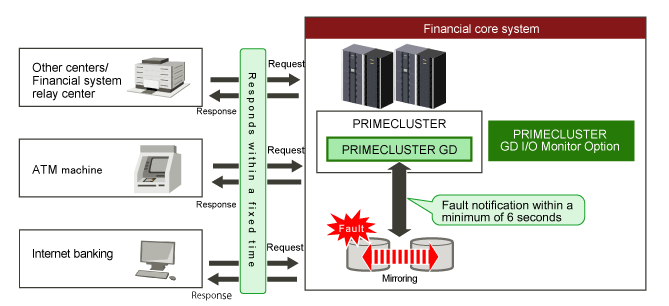GDS I/O Monitor Option is an optional software of GDS that provides additional function to GDS.
The transaction process must be finished within a given time in the database of the core system.
However when hardware or transfer route error occurs in the I/O device, I/O response may be delayed in order for the retry process or recovery and degradation to operate.
GDS I/O Monitor Option provides I/O response time assurance to ensure I/O response within a given time (default time is within 77 seconds) in order to avoid effects caused by I/O delay of the disk.
Figure 1.41 I/O Response Time Assurance

Features
The I/O responds within the specified time (default is within 77 seconds, shortest is within 6 seconds), even if the disk unit fails.
Effectiveness
Response can be realized in a short time for processing requests.
System slowdown and stopping of services caused by I/O response delay can be prevented.
Function overview
Mirror volume (mirroring the disk)
The error generated disk due to the I/O response delay is detached from mirroring and the operation can be continued by using the other normal disk.
Even when an error occurs with the other disk, the operation continues by switching to standby node (system restart for non-clustered system).
Single volume (not mirroring the disk)
When I/O response delay occurs, the operation continues by switching to standby node (system restart for non-clustered system).
The I/O response time can be set for each class. The following settings are possible:
Set different I/O response time on the disk that stores the system disk and user data.
Divide the disks to be used for each application to set different I/O response time.
System configuration
Server: Physical environment of PRIMEQUEST 3000 Series
Disk: Server built-in disk, ETERNUS DX series (FC connection)
Volume configuration of GDS: Mirror volume, single volume
Note
GDS I/O Monitor Option cannot be used in a system that uses a virtual environment or a cloud environment.
See
For operation details, see "1.8 I/O Response Time Assurance [IOmonitor]."
For general notes on system configuration and design, see "3.23 I/O Response Time Assurance [IOmonitor]."
For the settings method, see "6.12 I/O Response Time Assurance [IOmonitor]," "8.3 Changing the Settings of I/O Response Time Assurance [IOmonitor]," and "8.4 Deleting the Settings of the I/O Response Time Assurance [IOmonitor]."
For general notes on operation and maintenance, see "7.15 I/O Response Time Assurance [IOmonitor]."